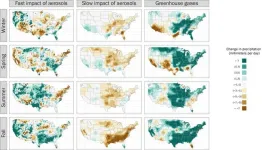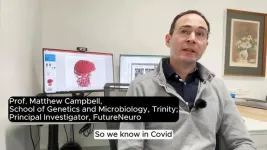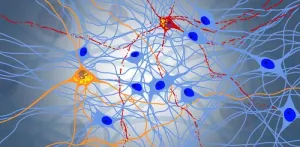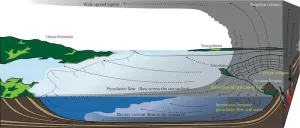(Press-News.org) MINNEAPOLIS / ST. PAUL (02/19/2024)—For the first time, researchers at the University of Minnesota Twin Cities (UMN) and the University of Illinois Urbana-Champaign (UIUC) have demonstrated that it is possible to provide accurate, high-resolution predictions of carbon cycles in agroecosystems, which could help mitigate the impacts of climate change.
The study by scholars from the UMN-led National Artificial Intelligence Institute for Climate-Land Interactions, Mitigation, Adaptation, Tradeoffs and Economy (AI-CLIMATE) and UIUC-led Agroecosystem Sustainability Center was recently published in Nature Communications, a peer-reviewed, open access, scientific journal.
The study’s findings are a critical first step in developing a credible Measurement, Monitoring, Reporting, and Verification (MMRV) of agricultural emissions that can be used to incentivize the implementation of climate smart practices while boosting rural economies. This follows the national strategy, set by the White House, highlighting the need to quantify greenhouse gas emission across sectors with a goal of net-zero emissions by no later than 2050.
Accurate, scalable, and cost-effective monitoring and reporting of greenhouse gas emissions are needed to verify what are called “carbon credits” or permits that offset greenhouse gas emissions. Farmers can be reimbursed for practices that reduce greenhouse gas emissions. Agriculture accounts for about 25 percent of greenhouse gas emissions, but large corporations can be hesitant about purchasing these credits without knowing how much carbon is being stored.
Right now, to accurately gather carbon data, a farmer would need to hire someone to come to their farm, take what is called a soil core (vertical profile of the soil), and send that back to the lab for analysis.
“To gather the amount of data needed at each individual farm, it could cost the farmers time and money that they may not be willing to give,” said Licheng Liu, the lead author and a research scientist in the University of Minnesota Department of Bioproducts and Biosystems Engineering.
The emerging field of Knowledge-Guided Machine Learning (KGML), pioneered by researchers at the University of Minnesota, combines the strength of artificial intelligence (AI) and process-based models from physical sciences. With observations in the United States Corn Belt, the KGML-ag framework significantly surpasses both process-based and pure machine learning models in accuracy, especially with limited data. Remarkably, KGML-ag operates over 10,000 times faster than traditional process-based models, delivering high-resolution and high-frequency predictions cost-effectively.
"These knowledge-guided machine learning (KGML) techniques are fundamentally more powerful than standard machine learning approaches and traditional models used by the scientific community to address environmental problems,” said Vipin Kumar, a University of Minnesota Regents Professor and William Norris Endowed Chair in the Department of Computer Science and Engineering and a researcher in the AI-CLIMATE Institute, whose group has pioneered the development of the KGML framework.
Instead of taking soil cores at every farm, with KGML-ag, researchers can use the power of satellite remote sensing, computational models, and AI to provide an estimate of carbon in each individual field. This allows for compensation to individual farmers that are fair and accurate. The researchers say this is key to fostering trust in carbon markets and supporting the adoption of sustainable practices.
"KGML-ag combines the most advanced understanding of mechanisms in agriculture with the state-of-the-art AI techniques and thus offers a new powerful lens to monitor and manage our agricultural ecosystems," said Zhenong Jin, the corresponding author for this study and assistant professor in the University of Minnesota Department of Bioproducts and Biosystems Engineering, who co-leads the KGML special interest group in the AI-CLIMATE.
Now, AI-CLIMATE researchers are investigating the potential of the KGML framework for forestry, leveraging its capabilities to address the pressing challenges in sustainable forestry management and the capturing and storing of carbon. The team is also exploring a KGML-based data assimilation approach to make use of the rapidly growing different kinds of satellite data flexibly.
“The KGML is one of the key research topics of the AI-CLIMATE,” said Shashi Shekhar, a University of Minnesota ADC Chair and Distinguished McKnight University Professor in the Department of Computer Science and Engineering and the lead researcher of the AI-CLIMATE Institute. “These initial results demonstrate the immense potential of AI for developing more accurate and cheaper methods for estimating emissions from agriculture. This may lubricate carbon markets and incentivize adoption of climate-smart practices.”
This collaborative work between researchers at the University of Minnesota and a team led by Kaiyu Guan at the University of Illinois Urbana-Champaign, was originally supported by the ARPA-E SMARTFARM program. Now, AI-CLIMATE researchers are taking this work to new heights leveraging richer data, knowledge, methods and use-cases..
To read the entire research paper titled, “Knowledge-guided machine learning can improve carbon cycle quantification in agroecosystems”, visit the Nature Communications website.
END
New study is first step in predicting carbon emissions in agriculture
New process is 10,000 times faster than current systems
2024-02-22
ELSE PRESS RELEASES FROM THIS DATE:
Air pollution hides increases in rainfall
2024-02-22
We know that greenhouse gas emissions like carbon dioxide should increase rainfall. The emissions heat the atmosphere, causing a one-two punch: warmer oceans make it easier for water to evaporate, and warmer air can hold more water vapor, meaning more moisture is available to fall as rain. But for much of the 20th century, that increase in precipitation didn’t clearly show up in the data.
A new study led by researchers at the Department of Energy’s Lawrence Berkeley National Laboratory (Berkeley ...
Damage to cell membranes causes cell aging
2024-02-22
Our cells are surrounded by a fragile membrane that’s only 5 nanometers thick, 1/20 of a soap bubble. Cells are easily damaged by physiological activities, including muscle contraction and tissue injury. To cope with such damage, cells are equipped with mechanisms that can repair membrane damage to a certain degree.
Mechanical damage to the cell membrane was previously believed to trigger two simple cellular outcomes: recovery or death. In this study, however, the researchers uncovered a third outcome – cellular senescence.
“When I started this project, I simply aimed to understand ...
Mice surprise: Australian researchers discover new native species
2024-02-22
Australia can lay claim to two new species of native rodent thanks to a study from The Australian National University (ANU).
The aptly named delicate mouse was previously thought to be a single species spanning a massive stretch of the country from the Pilbara in Western Australia, across parts of the Northern Territory and through Queensland down to the New South Wales border.
But researchers at ANU and CSIRO thought there might be more to the story.
Lead author Dr Emily Roycroft, from ANU, said we now know there ...
Latest research redefines neurodevelopmental risks, outcomes for congenital heart disease
2024-02-22
Statement Highlights:
A new American Heart Association scientific statement updates more than a decade of research identifying, managing and preventing neurodevelopmental delays and disorders among people with congenital heart disease.
The new statement outlines important changes since the Association’s last statement in 2012, such as revised criteria to determine which children and adults are at high risk for neurological developmental delays and disorders, as well as an updated list of factors that may increase the risk.
Critical next ...
Researchers discover underlying cause of “brain fog” linked with Long COVID
2024-02-22
Today, a team of scientists from Trinity College Dublin and investigators from FutureNeuro announced a major discovery that has profound importance for our understanding of brain fog and cognitive decline seen in some patients with Long COVID.
In the months after the emergence of the novel coronavirus SARS-CoV2 in late 2019 a patient-reported syndrome termed Long-COVID began to come to the fore as an enduring manifestation of acute infection.
Long COVID has up to 200 reported symptoms to date, but in general patients report lingering symptoms such as fatigue, ...
Carbon emissions from the destruction of mangrove forests predicted to increase by 50,000% by the end of the century
2024-02-22
The annual rate of carbon emissions due to the degradation of carbon stocks in mangrove forests is predicted to rise by nearly 50,000% by the end of the century, according to a new study published in IOP Publishing’s journal Environmental Research Letters. Mangroves in regions such as southern India, southeastern China, Singapore and eastern Australia are particularly affected.
Mangrove forests store a large amount of carbon, particularly in their soils, however human development in these areas has led to the degradation of these carbon ...
Cracking the code of neurodegeneration: New model identifies potential therapeutic target
2024-02-22
Scientists at the University of Zurich have developed an innovative neural cell culture model, shedding light on the intricate mechanisms underlying neurodegeneration. Their research pinpointed a misbehaving protein as a promising therapeutic target in the treatment of amyotrophic lateral sclerosis (ALS) and frontotemporal dementia (FTD).
Neurodegenerative diseases cause some of the neurons in our brains to die, resulting in different symptoms depending on the brain region affected. In amyotrophic lateral sclerosis (ALS), neurons in the motor cortex and spinal ...
Former Dutch minister and renowned gastroenterologist joins NTU Singapore as Vice President of Research
2024-02-22
Nanyang Technological University, Singapore (NTU Singapore) has appointed Professor Ernst Kuipers, a renowned gastroenterologist, healthcare executive, and former Minister of Health, Welfare and Sport for The Netherlands, as NTU Singapore’s new Vice President (Research).
Prof Kuipers will also be appointed to the tenured faculty rank of Distinguished University Professor, the highest faculty rank at NTU bestowed upon faculty members with extraordinary scholarly achievements that typically span multiple disciplinary boundaries.
Announcing this new appointment, NTU President Prof Ho Teck Hua said: “We warmly welcome ...
Biggest Holocene volcano eruption found by seabed survey
2024-02-22
A detailed survey of the volcanic underwater deposits around the Kikai caldera in Japan clarified the deposition mechanisms as well as the event’s magnitude. As a result, the Kobe University research team found that the event 7,300 years ago was the largest volcanic eruption in the Holocene by far.
In addition to lava, volcanos eject large amounts of pumice, ashes and gases as a fast-moving flow, known as “pyroclastic flow,” and its sediments are a valuable data source on past eruptions. For volcanoes on land, geologists understand the sedimentation mechanism of pyroclastic flows well, but the sediments themselves get lost easily ...
Generative AI used to create translatable pediatric care educational videos for hospitals in resource-poor countries
2024-02-22
Mass General Brigham pediatric clinicians created 45 videos on pediatric care topics including how-to for surgical procedures, best practices for intubation and intensive care, and translated them to Spanish through GPT-4 large language model.
Videos distributed to clinicians in Guatemala and Colombia
AI can offer health care professionals worldwide an inclusive resource for elevating pediatric standards of care, according to authors
A team of pediatric clinicians at Mass General Brigham have turned to generative artificial intelligence (AI) to tackle problems plaguing child medical care delivery in resource-poor countries that increase risk for poor outcomes and mortality.
The ...
LAST 30 PRESS RELEASES:
Heart-brain connection: international study reveals the role of the vagus nerve in keeping the heart young
Researchers identify Rb1 as a predictive biomarker for a new therapeutic strategy in some breast cancers
Survey reveals ethical gaps slowing AI adoption in pediatric surgery
Stimulant ADHD medications work differently than thought
AI overestimates how smart people are, according to HSE economists
HSE researchers create genome-wide map of quadruplexes
Scientists boost cell "powerhouses" to burn more calories
Automatic label checking: The missing step in making reliable medical AI
Low daily alcohol intake linked to 50% heightened mouth cancer risk in India
American Meteorological Society announces Rick Spinrad as 2026 President-Elect
Biomass-based carbon capture spotlighted in newly released global climate webinar recording
Illuminating invisible nano pollutants: advanced bioimaging tracks the full journey of emerging nanoscale contaminants in living systems
How does age affect recovery from spinal cord injury?
Novel AI tool offers prognosis for patients with head and neck cancer
Fathers’ microplastic exposure tied to their children’s metabolic problems
Research validates laboratory model for studying high-grade serous ovarian cancer
SIR 2026 delivers transformative breakthroughs in minimally invasive medicine to improve patient care
Stem Cell Reports most downloaded papers of 2025 highlight the breadth and impact of stem cell research
Oxford-led study estimates NHS spends around 3% of its primary and secondary care budget on the health impacts of heat and cold in England
A researcher’s long quest leads to a smart composite breakthrough
Urban wild bees act as “microbial sensors” of city health.
New study finds where you live affects recovery after a hip fracture
Forecasting the impact of fully automated vehicle adoption on US road traffic injuries
Alcohol-related hospitalizations from 2016 to 2022
Semaglutide and hospitalizations in patients with obesity and established cardiovascular disease
Researchers ‘listen in’ to embryo-mother interactions during implantation using a culture system replicating the womb lining
How changing your diet could help save the world
How to make AI truly scalable and reliable for real-time traffic assignment?
Beyond fragmented markets: A new framework for efficient and stable ride-pooling
Can shape priors make road perception more reliable for autonomous driving?
[Press-News.org] New study is first step in predicting carbon emissions in agricultureNew process is 10,000 times faster than current systems








